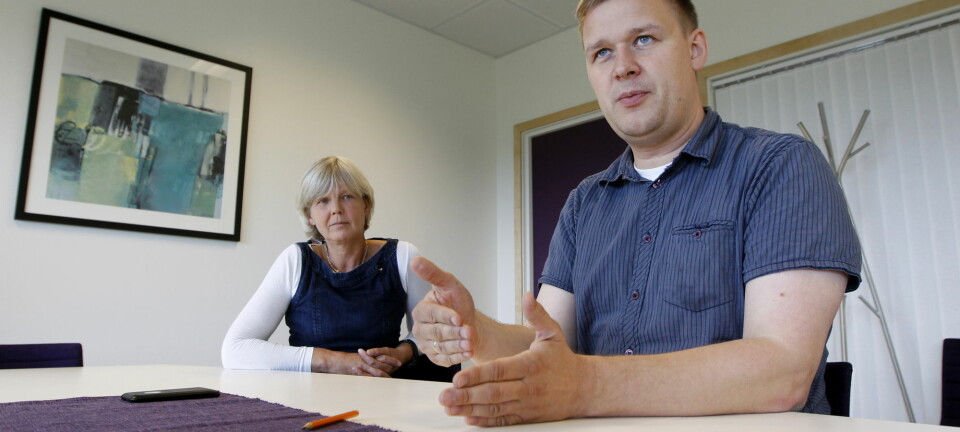
Online therapy: Many more people can get help with the fear of public speaking
Many people who suffer from social anxiety don’t dare to contact a psychologist. As a consequence, the people who struggle the most are the least likely to get help. A new study shows that online therapy is as effective as face-to-face therapy.
Many people probably recognize the feeling of standing in front of an assembly with your heart racing in your chest.
Everything you say sounds silly. When you say something wrong, everyone notices. Everyone sees that you’re sweating and turning red. At least that’s what you think.
“In reality, we all make little language mistakes and say things wrong when we speak. But few people actually notice. If you have a social phobia or public speaking anxiety, however, you become over-focused on yourself and don’t realize how little other people actually notice these very common and inevitable small mistakes,” says psychologist and researcher Omid Ebrahimi at the University of Oslo.
He recently published a scientific article on the treatment of social anxiety and what researchers call public speaking anxiety.
"Here we see that psychological therapy is effective for public speaking anxiety, and that therapy delivered via technology is as effective as traditional face-to-face therapy," Ebrahimi says.
Applies to most
Of all the things we are afraid of in the world, one thing often comes to the very top: speaking in public.
Most people have a greater or lesser fear of presenting to a small group of people or a larger crowd.
The fact that your heart is beating fast and the sweat is oozing out of you is not necessarily problematic.
“It doesn’t mean that everyone needs treatment from a therapist to manage it, nor does it necessarily mean that it’s a problem that you’re afraid to make a presentation. Usually, after a couple of attempts, you find it easier and your heartbeat goes down on its own,” says Ebrahimi.
It becomes a problem, though, when the fear is so great that it jeopardizes your quality of life and your duties and obligations at school or work, he says.
“If you start consciously avoiding all situations where you have to say something in front of a gathering and this has major effects on other areas of your life, then this is problematic. That could be a sign that you need help,” he says.

Up to one-third of the population feels so much discomfort standing in front of an audience when they speak that their affliction can be called problematic public speaking anxiety.
At worst, they may stop going to school or work altogether.
Baseball caps or high-necked sweaters
If people struggling with this anxiety force themselves to perform, they often use "unfortunate coping strategies," which psychologists call security behaviour.
For example, they put on a cap so that no one else can look them in the eyes or a high-necked sweater to hide that they are blushing.
“These are unfortunate strategies, because you miss out on experiencing that your discomfort with the situation can go away by itself, without having to use these strategies. These strategies consequently help maintain your fear,” Ebrahimi says.
Help is available
A social anxiety disorder consists of two parts, one of which is the fear of having a conversation with others.
The other is the fear of public speaking.
Many people fear the latter, but not the first. But studies show that the one is related to the other, Ebrahimi says.
The study he and researchers at the University of Bergen conducted shows that there is good help available, both for adults and for young people. Many people find that these fears are problematic already by their early teens.
The researchers have done a meta-study, which is a large study that investigats many individual studies. They have compared studies from many countries that have looked at the effects of different forms of therapy.
This is the first time such a study has been done only based on randomized and controlled public speaking anxiety studies, which is the "gold standard" in research.
Just as good effect
The researchers believe that the results from their meta-analysis show that many more people with social anxiety and public speaking anxiety can get help from therapy.
They have compared traditional psychological therapy, which consists of a face-to-face meeting between patient and therapist, to therapy delivered via technology. The latter may be an approach where the patient is treated by a therapist via the internet, so-called online therapy, or via virtual reality therapy.
“We found these to be equally effective. And these are important results. It increases the availability of treatment, and it increases the chance of a good match between the treatment method and the patient. We know that different patients can benefit from different treatment methods,” Ebrahimi says.
Half don't dare go to a psychologist
Nearly half of all people with a social anxiety disorder don’t contact a psychologist because the actual therapy situation where they have to meet another person makes them extremely anxious. As a consequence, the people who struggle most often do not receive help.
Psychologists are also not readily available everywhere in Norway. Another issue is that there are long waiting lists in many places. Many people also live far from a place where there is a psychologist.
“That makes it especially nice that it is just as effective to use technology in treatment,” Ebrahimi says.
Many more can get help
Offers of online treatment are now becoming more widespread in Norway. Online treatment is quite similar in many ways to working with a therapist face-to-face. But with online treatment, you write to a therapist instead of talking to him or her. Together, you work on tasks to help bring about change , he says.
“An online psychologist can treat up to four times as many patients as with face-to-face therapy. This could provide a short cut on the long waiting line for treatment in Norway, and we can help more people with the increased availability of these services,” Ebrahimi says.
Need more research
Kaja Asbjørnsen Betin is the head of the psychologists' association for digital health, DigPsyk. This is a professional association under the umbrella of the Norwegian Psychological Association.
She says that digital aids in mental health are a field of major international development.
“The speed with which this field is expanding in Norway has skyrocketed, especially over the last five years. An increasing number of psychologists are offering online treatment, although there are still only a few who work with it full time,” she says.

Betin is not surprised by Ebrahimi’s results, which show that traditional office therapy and therapy using digital tools have a similar effect, at least at the group level.
“Many studies show this. What we do not know as much about, however, is why it works, who it works for and who it doesn’t work for. We’re still partly in the dark here. We need more research,” she says.
Not for all disorders
Betin says that the disorders for which a digital approach works are phobias that are slightly more defined. But even mild to moderate depression and generalized anxiety disorders are now being treated online.
But there are areas where digital tools are not used and where it may not be as appropriate, she says.
“These include the more complex disorders, such as severe psychosis. Digital aids can be used here, but not on their own. They have to be coupled with other measures,” she says.
Must do what they fear most
When it comes to social anxiety and other phobias, a common component of most treatments is that the patient has to be exposed to what he or she fears. For example, if they’re afraid of spiders, they have to get used to spiders. Or they have to get more experience being in social contexts, such as a classroom, if they have a social phobia.
One example of how technology can be used in treatment is virtual reality. Creating a world similar to what the patient needs to practice in can be effective. Another approach may be guided internet therapy, where the patient is given instructions about exercises they can do.
“There are many benefits to this type of treatment. You can go for supervised treatment on the internet anytime and anywhere. You also have all the information in writing, so you don’t forget what was said in the therapy session,” Betin says.
Another benefit is that patients who find it difficult to sit face-to-face with a psychologist in an office find it easier to be more open when their treatment is via a computer program, she says.
Translated by: Nancy Bazilchuck
Reference:
O.V. Ebrahimi et.al: «Psychological Interventions for the Fear of Public Speaking: a Meta-Analysis», Frontiers in Psychology, March 10, 2019. https://doi.org/10.3389/fpsyg.2019.00488
———
Read the Norwegian version of this article at forskning.no

































